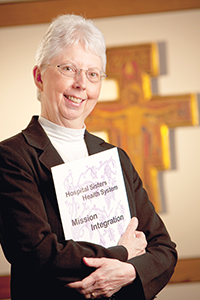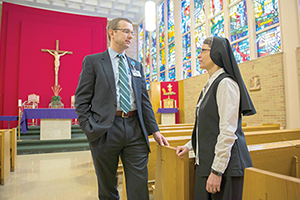By BETSY TAYLOR
Bringing together Catholic and other-than-Catholic health care facilities in the same system can be challenging work, but those who have done so say finding the places where the cultures overlap is one key to moving the integration work forward.

Sr. Laws
Sr. Monica Laws, OSF; Brian Yanofchick and Kyle Snyder, ministry leaders who have been involved in integrating Catholic hospitals into secular health care systems, or vice versa, talked to Catholic Health World about lessons learned and the importance of recognizing that changes go far beyond business transitions when integrating facilities with different cultural heritages. And they said communication and cultural, ethical and mission education need to be ongoing.
Comfortable fit
Sr. Laws, vice president of mission integration for Hospital Sisters Health System in Springfield, Ill., talked about bringing three unrelated secular hospitals — Community Memorial Hospital in Oconto Falls, Wis.; Greenville Regional Hospital in Greenville, Ill.; and Shelby Memorial Hospital in Shelbyville, Ill. — into the HSHS system in the last few years. The hospitals became Catholic facilities.
Sr. Laws said the Catholic health system had health care partnerships with the hospitals before they joined HSHS. The parties involved "were comfortable their values aligned with ours," and that health care would be strengthened in each region if the hospitals joined HSHS.
It falls to local ordinaries, or bishops, to affirm the Catholic identity of hospitals. When HSHS was negotiating to acquire the secular hospitals and convert them to Catholic facilities, it reached out to the respective bishops to open lines of communication. Sr. Laws said that early on HSHS leaders had frank conversations with hospital and community leaders to discuss the system's Catholic values and learn about the values of the community and the secular hospital. Community leaders are part of the work because HSHS has found a change in a hospital's owners affects a whole community.
Sr. Laws said in each acquisition HSHS created a Catholic identity and culture committee, made up of HSHS leaders in strategy, finance, human resources and mission. Subcommittees, which include representatives from the secular hospital joining the system, are involved in work related to business and cultural integration.
Sr. Laws said HSHS involved leaders and physicians at the acquired hospitals in choosing facility names consistent with the new Catholic identity. Community and hospital leaders in Oconto Falls felt an affinity for the work of St. Clare and the facility was renamed HSHS St. Clare Memorial Hospital. In Greenville, leaders stressed strong family, which led to the name HSHS Holy Family Hospital. Community members in Shelbyville responded favorably to calling the hospital HSHS Good Shepherd Hospital.

Geisinger Holy Spirit's Chief Administrative Officer Kyle Snyder and the hospital's Mission Integration Officer Sr. Mary Joseph Albright, SCC, are in the chapel of the Camp Hill, Pa., medical center.
HSHS added or expanded chapels in its newly Catholic facilities. Each HSHS hospital has a mission leader on-site, and he or she reports annually to a mission integration committee about Catholic identity and mission. Members of the committee make site visits on a rotating basis. "I think it's invaluable to stay connected," Sr. Laws said of the ongoing mission integration work. "It's not a 'one and done.'"
Change is hard
Snyder is chief administrative officer for Geisinger Holy Spirit, a Catholic hospital in Camp Hill, Pa., sponsored by the Sisters of Christian Charity. Holy Spirit joined with the secular Geisinger health care system in 2014. As a condition of the acquisition, Holy Spirit remained Catholic.
Snyder said change is always hard for organizations and the people in those organizations. He said an important role for leaders is "managing the pace, the level of intensity of that change" and making sure that people realize they're working toward a common purpose — in this case to strengthen the health care system and improve care.
"You don't want to lose the good parts about what makes an organization like Holy Spirit a success and such a wonderful resource for the community."
He said part of the work of integrating a hospital into a system involves understanding that people in a workplace have things they need to get done, and that even changes that increase efficiency may be resisted if they disrupt the status quo. A decision on whether to change to a new supplier, or modify a physician employment agreement, should anticipate and weigh the potentially disruptive impact on stakeholders, he said.
Geisinger Holy Spirit uses a variety of tools, including videos, to educate new employees about its Catholic history and community ties. Sr. Mary Joseph Albright, SCC, Geisinger Holy Spirit's mission integration officer, has breakfast meetings the first Friday of every month with physicians and other clinical providers like nurse practitioners, nurse anesthetists and physician assistants to educate them about the hospital's Catholic mission and about the Ethical and Religious Directives for Catholic Health Care Services.
Listen and communicate
The work to bring together health care facilities from diverse cultures in one system can initially feel like hosting a Thanksgiving dinner with lots of guests who have different points of view, said Yanofchick. Respect and understanding can go a long way toward harmony around the table. He's the senior vice president of sponsorship for growth strategies and business development for Bon Secours Health System. Yanofchick previously held positions at Kentucky-One Health and CHA focused on mission integration and leadership development.
KentuckyOne Health, part of Englewood, Colo.-based Catholic Health Initiatives, brought together hospitals from a Catholic tradition, a Jewish tradition and a university health system in its Louisville market. Yanofchick said work to integrate these cultures involved both affirming the identity of each hospital and bringing them together under shared mission and values.
Values integration is a process that requires ongoing intentionality, he said.
In the integration work, Yanofchick said there was great effort to find commonalities between the Catholic, Jewish and academic traditions of the hospitals.
Yanofchick said when health care facilities come together from different traditions, he believes in conducting "mission due diligence." He said the process should include conversations about "who do we say we are?" and the "whys" of the partnership. "What are we trying to achieve with this?" While the reasons for coming together can differ by party, the rationale needs to be compatible, he said.
KentuckyOne Health has reorganized its statewide operations and is reducing its holdings in Louisville in particular. As part of that, last July the University of Louisville Hospital resumed self-management, terminating its management agreement with KentuckyOne. Jewish Hospital Louisville and Jewish Hospital Shelbyville are among the nine facilities KentuckyOne is working to divest statewide. Yanofchick said the market reorganization in Louisville was a business decision and not related to cultural differences.
Copyright © 2018 by the Catholic Health Association
of the United States
For reprint permission, contact Betty Crosby or call (314) 253-3490.